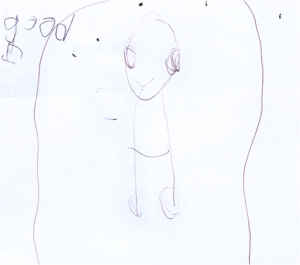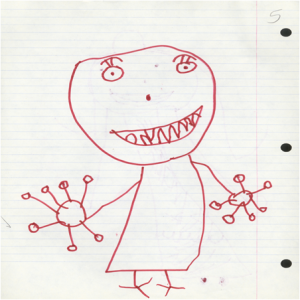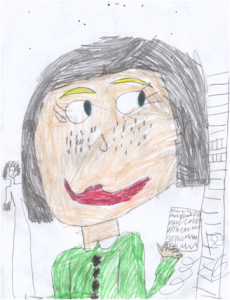Children between the ages of 2 and 6 years tend to grow about 3 inches in height each year and gain about 4 to 5 pounds in weight each year. The average 6-year-old weighs about 46 pounds and is about 46 inches in height. The 3-year-old is very similar to a toddler with a large head, large stomach, short arms and legs. But by the time the child reaches age 6, the torso has lengthened and body proportions have become more like those of adults.
This growth rate is slower than that of infancy and is accompanied by a reduced appetite between the ages of 2 and 6. This change can sometimes be surprising to parents/caregivers and lead to the development of poor eating habits.
Nutritional Concerns
Caregivers who have established a feeding routine with their child can find this reduction in appetite a bit frustrating and become concerned. However, by providing adequate, sound nutrition, and limiting sugary snacks and drinks, the caregiver can be assured that 1) the child will not starve; and 2) the child will receive adequate nutrition. Preschoolers can experience iron deficiencies if not given well-balanced nutrition and if given too much milk. Calcium interferes with the absorption of iron in the diet as well.
Caregivers also need to keep in mind that they are setting up taste preferences at this age. Young children who grow accustomed to high fat, very sweet and salty flavors may have trouble eating foods that have more subtle flavors such as fruits and vegetables. Consider the following advice about establishing eating patterns for years to come (Rice, F.P., 1997). Notice that keeping mealtime pleasant, providing sound nutrition and not engaging in power struggles over food are the main goals:
Tips for Establishing Healthy Eating Patterns
- Don’t try to force your child to eat or fight over food. Of course, it is impossible to force someone to eat. But the real advice here is to avoid turning food into some kind of ammunition during a fight. Do not teach your child to eat to or refuse to eat in order to gain favor or express anger toward someone else.
- Recognize that appetite varies. Children may eat well at one meal and have no appetite at another. Rather than seeing this as a problem, it may help to realize that appetites do vary. Continue to provide good nutrition, but do not worry excessively if the child does not eat.
- Keep it pleasant. This tip is designed to help caregivers create a positive atmosphere during mealtime. Mealtimes should not be the time for arguments or expressing tensions. You do not want the child to have painful memories of mealtimes together or have nervous stomachs and problems eating and digesting food due to stress.
- No short order chefs. While it is fine to prepare foods that children enjoy, preparing a different meal for each child or family member sets up an unrealistic expectation from others. Children probably do best when they are hungry (not overly hungry though) and a meal is ready. Limiting snacks rather than allowing children to “graze” continuously can help create an appetite for whatever is being served.
- Limit choices. If you give your preschool aged child choices, make sure that you give them one or two specific choices rather than asking “What would you like for lunch?” If given an open choice, children may change their minds or choose whatever their sibling does not choose!
- Serve balanced meals. This tip encourages caregivers to serve balanced meals. A box of macaroni and cheese is not a balanced meal. Meals prepared at home tend to have better nutritional value than fast food or frozen dinners. Prepared foods tend to be higher in fat and sugar content as these ingredients enhance taste and profit margin because fresh food is often more costly and less profitable. However, preparing fresh food at home is not costly. It does, however, require more activity. Preparing meals together and including the children in kitchen chores can provide a fun and memorable experience.
- Don’t bribe. Bribing a child to eat vegetable by promising desert is not a good idea. For one reason, the child will likely find a way to get the desert without eating the vegetables (by whining or fidgeting, perhaps, until the caregiver gives in), and for another reason, because it teaches the child that some foods are better than others. Children tend to naturally enjoy a variety of foods until they are taught that some are considered less desirable than others. A child, for example, may learn the broccoli they have enjoyed is seen as yucky by others unless it’s smothered in cheese sauce!
To what extent do these tips address cultural practices? How might these tips vary by culture? These are also things to consider, of course.
Brain Maturation
Brain weight: If you recall, the brain is about 75 percent its adult weight by two years of age. By age 6, it is at 95 percent its adult weight. Myelination and the development of dendrites continues to occur in the cortex and as it does, we see a corresponding change in what the child is capable of doing. Greater development in the prefrontal cortex, the area of the brain behind the forehead that helps us to think, strategize, and control emotion, makes it increasingly possible to control emotional outbursts and to understand how to play games. Consider 4 or 5 year old children and how they might approach a game of soccer. Chances are, every move would be a response to the commands of a coach standing nearby calling out, “Run this way! Now, stop. Look at the ball. Kick the ball!” And, when the child is not being told what to do, they are likely to be looking at the clover on the ground or a dog on the other side of the fence! Understanding the game, thinking ahead, and coordinating movement improves with practice and myelination. Not being too upset over a loss, hopefully, does as well.
Visual Pathways
Have you ever examined the drawings of young children? If you look closely, you can almost see the development of visual pathways reflected in the way these images change as pathways become more mature. Early scribbles and dots illustrate the use of simple motor skills.
At age 3, the child begins to draw wispy creatures with heads and not much other detail. Gradually, pictures begin to have more detail and incorporate more parts of the body. Arm buds become arms and faces take on noses, lips and eventually eyelashes. Look for drawings that you or your child have created to see this fascinating trend. Here are some examples of pictures drawn by kids from ages 2 to 7 years.


Growth in the hemispheres and corpus callosum: Between ages 3 and 6, the left hemisphere of the brain grows dramatically. This side of the brain or hemisphere is typically involved in language skills. The right hemisphere continues to grow throughout early childhood and is involved in tasks that require spatial skills such as recognizing shapes and patterns. The corpus callosum which connects the two hemispheres of the brain undergoes a growth spurt between ages 3 and 6 as well and results in improved coordination between right and left hemisphere tasks. (
Motor Skill Development
Early childhood is a time when most children are especially attracted to motion and song. Every place becomes a potential playground. Even the booth at a restaurant may afford the opportunity to slide around in the seat or disappear underneath and imagine being a sea creature in a cave! Of course, this can be frustrating to a caregiver, but it’s the business of early childhood. Children continue to improve their gross motor skills as they run and jump, as their bodies permit. And, frequently ask their caregivers to “look at me” while they hop or roll down a hill. Children’s songs are often accompanied by arm and leg movements or cues to turn around or move from left to right. Fine motor skills are also being refined in activities such as pouring water into a container, drawing, coloring, and using safe scissors.
Some children’s songs promote fine motor skills as well (have you ever heard of the song “itsy, bitsy, spider”?). Mastering the fine art of cutting one’s own fingernails or tying shoes will take a lot of practice and maturation. Motor skills continue to develop in middle childhood-but for preschoolers, play that deliberately involves these skills is emphasized.
Go ahead. Sing along and practice your fine motor skills.






